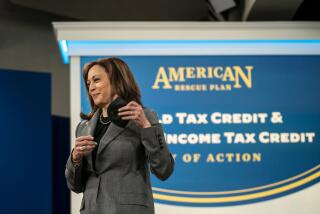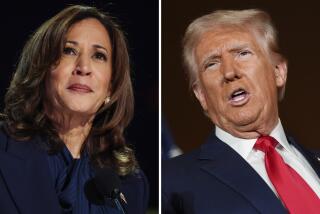McManus: The bottom line on taxes
On April 15, everyone’s in favor of tax reform.
Nobody can survive the ordeal of preparing a federal income tax return without concluding that there must be a simpler, fairer way to pay for the federal government.
And so — as inevitably as death and, well, you know — the presidential campaigns promise us some kind of tax reform.
President Obama spent much of last week promoting his “Buffett rule,” a proposal to require anyone who makes more than $1 million year to pay federal taxes at a minimum of 30%. It’s a matter of basic fairness, he says.
Mitt Romney, the presumptive Republican candidate, rejects the Buffett rule — and all other tax increases, for that matter. He says he’d reform the system by lowering tax rates for everybody and pay for it by reducing tax deductions and cutting federal spending.
And there’s the problem: Both candidates claim they want “tax reform,” but when they say those words, they’re really talking about other things.
Obama’s Buffett rule wouldn’t clean up the tax code; in fact, it would add more complexity. It’s a campaign talking point framed as an easily understandable appeal for equity, and one that also takes a swipe at Romney, who paid an effective tax rate of about 14% in 2010.
Obama says he’s for comprehensive tax reform, but he’s never actually offered a full-scale tax plan, merely a bare-bones list of principles (lower rates, simplification) stapled to proposals that don’t always easily fit them (higher rates for the wealthy, the Buffett rule).
Romney’s “reform” isn’t much better. His proposal is really about reducing the burden on upper-income taxpayers and shrinking the federal government, not fixing the tax code. It’s an appendix to his overall budget plan, which would reduce federal domestic spending by at least $500 billion (by 2016) while increasing military spending.
Romney says he wants to limit the deductions, exemptions and credits that upper-income taxpayers can claim, a laudable half-step toward tax efficiency. But his plan doesn’t specify anything, which means, in the end, that it’s not much simpler or more specific than Obama’s proposals.
So what sounds like a campaign debate over taxes is really just 2012’s version of the perennial argument over the proper size and scope of the federal government. How we pay for it — the shape of the tax system — is an afterthought. Oddly, that may not be a bad thing. As Obama’s former economic advisor Larry Summers wrote recently, an election campaign is a bad place to make wise tax policy.
“The more tax issues are discussed during the campaign,” Summers wrote in the Financial Times, “the more the candidates will be driven to make ... pledges that might make tax reform that much more difficult.”
And it is difficult. But not because the sides are miles apart. Among policy wonks and thoughtful politicians, there’s a fair amount of bipartisan consensus that, to achieve efficiency, fairness and simplicity, we need fewer tax incentives that distort economic decisions. Even Obama and Romney agree in theory on the basic principles: establish lower tax rates (on most taxpayers, at least) and a broader tax base (meaning fewer deductions and exclusions).
The problem with getting it done is this: Everyone loves lower tax rates. But almost everyone also loves his or her favorite tax deduction.
The easiest, most efficient way to lower tax rates and streamline the tax system would be to eliminate “tax expenditures,” the deductions and exclusions that shelter big chunks of income from taxation. That would make your tax return much simpler and bring in billions of dollars of new revenue.
But look at the three biggest tax expenditures last year. First comes the tax-free treatment of health insurance premiums paid by employers; in 2008, Republican candidate John McCain proposed abolishing it as a sensible economic move, and Obama denounced that as a heartless attack on healthcare. Second, the mortgage interest deduction, which the real estate industry promotes as help for first-time home buyers even though it also subsidizes million-dollar vacation homes. Third: tax deductible contributions to 401(k) retirement plans. No politician is eager to wade into the buzz saw of protests that would greet a proposal to abolish any of those.
That helps explain why our last big tax reform, in 1986, came between presidential elections. It took a second-term president, Ronald Reagan, who was broadly popular; a House of Representatives with a secure Democratic majority; a healthy economy; and a declining federal deficit to eliminate dozens of loopholes and reduce the top marginal tax rate to 28%. (It crept back up to 39.6% by 1993; it’s currently 35%.)
Could the next president take us there again? Don’t bet on it. A second-term President Obama isn’t likely to get much help from Congress if the House of Representative stays in Republican hands. A first-term President Romney would hesitate to take the electoral risks that real tax reform demands.
So when the presidential candidates tell you they’re all for tax reform, take it with a grain of salt. What they mean is this: They’re for shifting the tax burden up (Obama) or down (Romney); for increasing revenues (Obama) or shrinking government (Romney). Fixing our tangled, infuriating, inefficient tax code? Sorry. That will just have to wait for another day.
More to Read
Get the L.A. Times Politics newsletter
Deeply reported insights into legislation, politics and policy from Sacramento, Washington and beyond. In your inbox three times per week.
You may occasionally receive promotional content from the Los Angeles Times.











